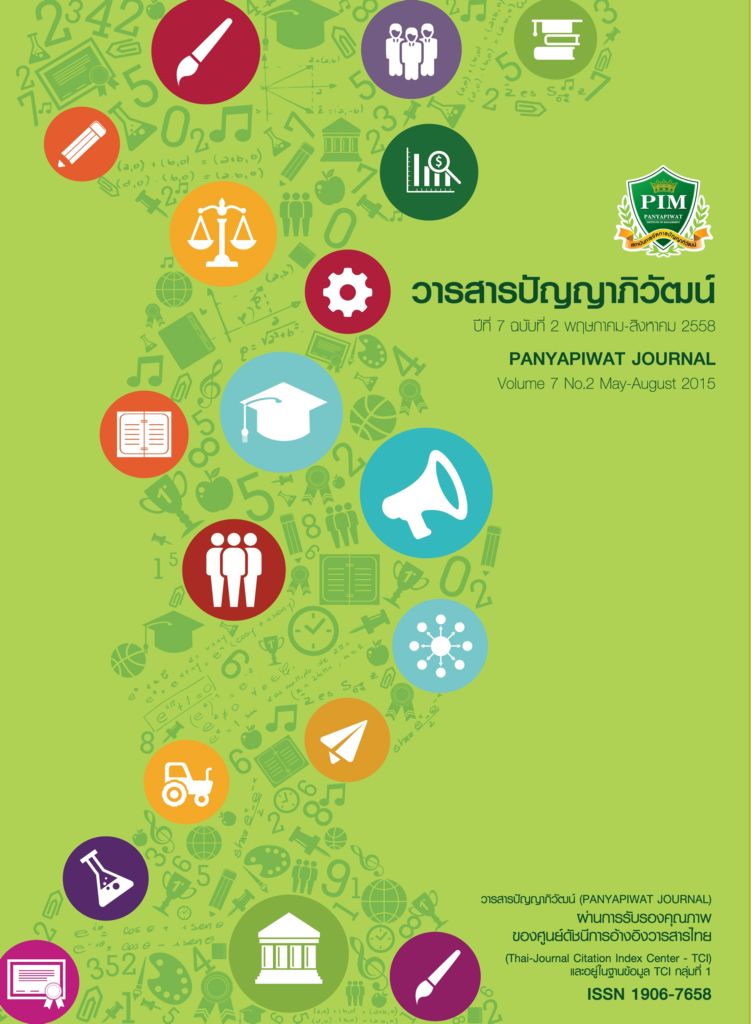ตัวแบบสมรรถนะแฟรนไชซี กรณีศึกษาแฟรนไชซีร้านค้าปลีก บริษัท XYZ จำกัด
Main Article Content
บทคัดย่อ
บทคัดย่อ
ร้านค้าปลีกเป็นธุรกิจที่มีความสำคัญต่อธุรกิจของประเทศอย่างมาก มีรายได้ภาพรวมของอุตสาหกรรม
เป็นอันดับสองรองจากภาคอุตสาหกรรม และมีการจ้างงานมากเป็นอันดับสามรองจากภาคเกษตรและภาคบริการการเจริญเติบโตของการค้าปลีกส่วนหนึ่งเกิดจากการดำเนินธุรกิจแบบแฟรนไชส์ โดยการมอบสิทธิในการบริหารให้บุคคลภายนอกที่เรียกว่าแฟรนไชซี ดังนั้น การพัฒนาสมรรถนะของแฟรนไชซี ให้อยู่ในระดับสูงสุดจึงสร้างความสามารถในการแข่งขันที่ยังยืน บทความวิจัยนี้เป็นการศึกษาเพื่อสร้างตัวแบบสมรรถนะที่เป็นเลิศของแฟรนไชซีร้านค้าปลีก และออกแบบการพัฒนาที่ทำให้แฟรนไชซีที่มีผลประกอบการระดับปานกลางถึงต่ำ สามารถเข้ามารับการพัฒนาเพื่อเพิ่มขีดความสามารถในการดำเนินธุรกิจให้สูงขึ้นอย่างต่อเนื่อง โดยการวิจัยนี้มีวัตถุประสงค์ 2 ประการ คือ (1) เพื่อสร้างตัวแบบสมรรถนะ (Competency Model) ของแฟรนไชซีที่มีขีดความสามารถสูง และ (2) เพื่อนำตัวแบบสมรรถนะที่ค้นพบไปใช้ในการสรรหาและพัฒนาแฟรนไชซี โดยใช้การทบทวนวรรณกรรมเพื่อกำหนดกรอบแนวความคิด ซึ่งการวิจัยนี้เป็นการวิจัยเชิงคุณภาพ โดยการสัมภาษณ์แบบเจาะลึก (Depth Interview) ด้วยวิธีเทคนิค Critical Incident Interview แฟรนไชซีที่มีผลประกอบการระดับดีมากในระดับ 90 เปอร์เซ็นไทล์ขึ้นไป จำนวน 9 คน และสัมภาษณ์แฟรนไชซี ที่มีผลประกอบการระดับดี คือ ระดับเปอร์เซ็นไทล์ที่ 40-60 จำนวน 6 คน และยืนยันโดยผู้บริหารระดับการกำกับดูแลร้านสาขาโดยตรง จำนวน 18 คน สามารถสรุปเป็นสมรรถนะของแฟรนไชซีได้ 3 กลุ่ม คือ สมรรถนะหลัก (Core Competency) ประกอบด้วยทักษะความเป็นเจ้าของ (Entrepreneurial Skill) ความเชื่อมั่นในบริษัท (Trust) และการมีใจเปิดกว้าง (Open Mind) สมรรถนะตามบทบาทหน้าที่ (Functional Competency) ประกอบด้วย มาตรฐานร้าน (Store Standard) และสมรรถนะด้านผู้นำ (Leadership Competency) ประกอบด้วยการนำโดยทำ
เป็นแบบอย่าง (Lead by Example) และการดูแลพนักงาน (Leading People) ข้อเสนอจากงานวิจัยนี้มีประโยชน์ ในการนำไปใช้ในการสรรหา คัดเลือกแฟรนไชซีที่มีความรู้ ความสามารถ อีกทั้งใช้ในการกำหนดแนวทางการพัฒนาที่สอดคล้องกับความต้องการของธุรกิจแฟรนไชส์ การจัดทำแผนการฝึกอบรมและพัฒนาบุคลากรรายบุคคลให้ถูกต้องตามความจำเป็น ตรงกับวัตถุประสงค์ เพื่อให้การดำเนินธุรกิจแฟรนไชส์ได้ตามมาตรฐานที่กำหนด การจัดทำเส้นทางความก้าวหน้าในอาชีพ เพื่อให้บุคลากรที่มีความรู้ ความสามารถ ตามที่กำหนดไว้ได้ก้าวไปสู่หน้าที่การงานที่สูงขึ้นได้อย่างเป็นธรรม และการพัฒนาศักยภาพ แฟรนไชซีเพื่อเพิ่มขีดความสามารถในการแข่งขันในอนาคต
Abstract
Retail business is vital to the country’s business. It has the largest overall revenue industrial sector and the largest employment rate third from agricultural and service second sectors. Franchise business is one of the largest growth business by outsourcing business management to the third parties. Therefore, the development of the franchisee competency to the highest level is the sustainable competitive advantage. This paper aims to study and create a model of excellence competency for retail franchisee and to design a development program that allows the moderate to low business performance franchisee to be developed for enhancing the business capability continuously. The purposes of this study are: (1) to generate a competency model of high capability franchisee, and (2) to utilize competency model in recruitment and development of franchisee.
This qualitative research is conducted by a literature review to determine the conceptual framework and the critical incident interview is applied to excellent performance franchisee of the 90 percentile (total of 9 persons), good performance franchisee of the 40 – 60 percentile (total of 6 persons) and validated by branch executives, supervising franchisee directly (total of 18 persons). The franchisee competency can be summarized into 3 dimensions as follow: (1) Core competency includes entrepreneurial skill, trust in company and open-minded, (2) Functional competency includes store standard and (3) Leadership competency includes leading by example and leading people. The findings from this research are useful in franchisee recruitment and selection, determining the course of learning and development in order to keep the standard of franchise business as well as to increase franchisee’s potential for competitiveness in the future.
Article Details
“ข้าพเจ้าและผู้เขียนร่วม (ถ้ามี) ขอรับรองว่า บทความที่เสนอมานี้ยังไม่เคยได้รับการตีพิมพ์และไม่ได้อยู่ระหว่างกระบวนการพิจารณาลงตีพิมพ์ในวารสารหรือแหล่งเผยแพร่อื่นใด ข้าพเจ้าและผู้เขียนร่วมยอมรับหลักเกณฑ์การพิจารณาต้นฉบับ ทั้งยินยอมให้กองบรรณาธิการมีสิทธิ์พิจารณาและตรวจแก้ต้นฉบับได้ตามที่เห็นสมควร พร้อมนี้ขอมอบลิขสิทธิ์บทความที่ได้รับการตีพิมพ์ให้แก่สถาบันการจัดการปัญญาภิวัฒน์หากมีการฟ้องร้องเรื่องการละเมิดลิขสิทธิ์เกี่ยวกับภาพ กราฟ ข้อความส่วนใดส่วนหนึ่งและ/หรือข้อคิดเห็นที่ปรากฏในบทความข้าพเจ้าและผู้เขียนร่วมยินยอมรับผิดชอบแต่เพียงฝ่ายเดียว”
เอกสารอ้างอิง
ผู้จัดการออนไลน์. (2558). สำรวจสถานการณ์แฟรนไชส์ดําวรุ่งปี 58. สืบค้นเมื่อ 5 มกราคม 2558, จาก http://www.manager.co.th/iBizchannel/ViewNews.aspx?NewsID=9570000147884
พลานุภาพ พสุธาภูวดล. (2552). แฟรนไชส์กับความสำเร็จของผู้นำร้ํานสะดวกซื้อ. สารนิพนธ์หลักสูตรปริญญาเศษฐศาสตร์มหาบัณฑิต, มหาวิทยาลัยรามคำแหง.
สำนักงานส่งเสริมวิสาหกิจขนาดกลางและขนาดย่อม. (2556). เริ่มต้นธุรกิจด้วยแฟรนไชส์. สืบค้นเมื่อ 26 พฤศจิกายน 2556, จาก http://www.sme.go.th/ SiteCollectionDocuments/บทความ/sep-2556/5.เริ่มต้นธุรกิจด้วยแฟรนไชส์(สง.).pdf
สำนักงานส่งเสริมวิสาหกิจขนาดกลางและขนาดย่อม. (2552). รายงานภาวะเศรษฐกิจวิสาหกิจขนาดกลางและขนาดย่อม สาขาการค้ําปลีกและค้ําส่ง. ไม่ปรากฏสถานที่พิมพ์.
สถาบันพัฒนาวิสาหกิจขนาดกลางและขนาดย่อม. (2557). รายงานการศึกษาขั้นสุดท้ําย (Final Report) การจัดทำยุทธศาสตร์และแผนปฏิบัติการส่งเสริมวิสาหกิจขนากกลางและขนาดย่อม. ไม่ปรากฏสถานที่พิมพ์.
สุนันทา ไชยสระแก้ว. (2553). ความสำคัญของกํารสนับสนุนของแฟรนไชส์ซอกับวัฒนธรรมองค์กรที่มีต่อคุณภาพความสัมพันธ์ของแฟรนไชส์ซอร์-แฟรนไชส์ซี. มหาวิทยาลัยศรีปทุม.
อภิรดี สัตตะรุจาวงษ์. (2553). ปัจจัยที่มีผลต่อการเลือกเป็นแฟรนไชส์เซเว่นอีเลฟเว่นของผู้ที่สนใจประกอบธุรกิจแฟรนไชส์ในประเทศไทย. วิทยานิพนธ์ บริหารธุรกิจมหาบัณฑิต, สถาบันการจัดการปัญญาภิวัฒน์.
Dant, R. P., Weaven, S. K. & Baker, B. L. (2013). Influence of personality traits on perceived relationship quality within a franchisee-franchisor context. European Journal of Marketing, 47(1/2), 279-302.
Dickey, M. H., McKnight, D. H. & George, J. F. (2008). The role of trust in franchise organizations. International Journal of Organizational Analysis, 15(3), 251-282.
Dubois, D. & Rothwell, W. (2004). Competency-Based Human Resource Management. California: Davies-Black Publishing.
Davis, P. J. (2012). A model for strategy implementation and conflict resolution in the franchise business. Strategy & Leadership, 40(5), 32-38.
Davies, M. A., Lassar, W., Manolis, C., Prince, M. & Winsor, R. D. (2011). A model of trust and compliance in franchise relationships. Journal of Business Venturing, 26(3), 321-340.
Drucker, P. F. (2006). The Effective Executive: The Definitive Guide to Getting the Right Things Done. New York: HarperCollins Publishers.Green, P. C. (1999). Building robust competencies. San Francisco, CA: Jossey-Bass.
Lim, J. & Frazer, L. (2004). Exploring the link between goal congruence and satisfaction in the franchising channel. In The Academy of World Business, Marketing and Management Development. The Academy of World Business, Marketing, and Management Development.
Lim, J. & Frazer, L. (2004). Matching franchisor-franchisee roles and competencies. In 18th Annual International Society of Franchising Conference, Las Vegas.
Maxwell, J. C. (2007). The 21 Indispensable Qualities of a Leader: Becoming the Person OthersWill Want to Follow. Tennessee: Thomas Nelson.
Meiseberg, B. (2010). Social capital transfer and performance in franchising. In Robert Mittelstaedt Doctoral Symposium Proceedings (p. 99).
Rothwell, W. J. & Lindholm, J. E. (1999). Competency identification, modelling and assessment in the USA. International journal of training and development, 3(2), 90-105.
Scott, D. L., Frazer, L. & Weaven, S. K. W. (2006). Franchise unit success factors. In ANZMAC 2006 Conference. Queensland University of Technology.
Spencer, L. M. & Spencer, S. M. (1993). Competency at work. New York: John Wiely & Sons.
Wu, W. W. (2009). A competency-based model for the success of an entrepreneurial start-up. WSEAS Transactions on Business and Economics, 6(6), 279-291.
Translated Thai References
Chaisrakaew, S. (2010). The Important of Franchisor Support and Organizational Culture toward Franchisor-Franchisee Relationship Quality. Sripatum University. [in Thai]
Manager Online. (2558). Explore the situation of rising star franchise’s 58. Retrieved January 5, 2015, from http://www.manager.co.th/iBizchannel/ViewNews.aspx?NewsID=9570000147884 [in Thai]
Office of Small and Medium Enterprises Promotion. (2009). Small and Medium Enterprises Economic Report: Retail and Wholesale. Publisher does not appear. [in Thai]
Office of Small and Medium Enterprises Promotion. (2013). Starting a franchise business. Retrieved November 26, 2013, from http://www.sme.go.th/ SiteCollectionDocuments/บทความ/sep-2556/5.เริ่มต้นธุรกิจด้วยแฟรนไชส์(สง.).pdf [in Thai]
Office of Small and Medium Enterprises Promotion. (2014). Final Report of Small and Medium Enterprises Promotion’s the Strategy and Action Plan. Publisher does not appear. [in Thai]
Pasuthaphuwadon, P. (2009). The franchise ‘s success with leading convenience store. Master Project, Master of Economic. Ramkamhaeng University. [in Thai]
Sattarujawong, A. (2556). Factors Influencing The Decision of The Franchise’s 7 ELEVEN of Those Interested in a Franchise Business. Master of Business Administration (Business Administration).Faculty of Business Administration, Panyapiwat Institute of Management. [in Thai]


